The Lancaster Methods of Raising Calves
A good start for calves:
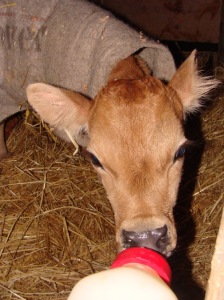 Three feedings of colostrum after birth, about every 12 hours. (At birth; 12 hours after birth; 24 hours after birth)
Three feedings of colostrum after birth, about every 12 hours. (At birth; 12 hours after birth; 24 hours after birth)
- Ideally, from the mother at time of birth (if safe – meaning the mother has no known transmissible disease), or
- from another cow’s clean/safe colostrum (fresh or frozen), or
- if unable to do one of the above options, there is the choice of purchasing commercially prepared colostrum powder (feed as directed on package).
We feed one full bottle (2 quarts) as soon after birth as possible, hand-milking the cow’s colostrum right into the bottle.

We recommend Merrick brand bottle & nipple. Be sure the nipple on your bottle is not too soft. If the nipple drips a lot or streams out when you hold the bottle upside-down, then please replace with a newer one as the hole is too big and could cause the calf to aspirate milk into its lungs. Throw away the old nipple. Regularly clean the bottle and nipple, being careful to rinse off all cleaning agents. A large bottle brush is helpful to clean inside the bottle.
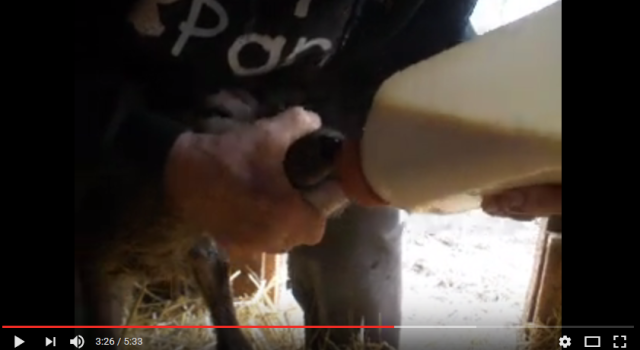
The cow will get milked again in a few hours, or at the next milking time. We find that the calf does best on the freshest milk, so instead of trying to re-warm the first milking, it’s best to feed the calf from the current, fresh milking.
The first milking’s colostrum (what is left over after you feed the calf) can be kept and frozen for future use (for your use or someone may want to buy some from you for their animals or for emergencies). We like to pour the milk into freezer gallon or quart ziplock bags. Be sure to label with the cow’s name and the date. Read more on colostrum handling here: Freezing and Thawing Colostrum
Additional Resource: Off to a Good Start: Calf Care in Week 1 by Drew Vermeire

HOUSING: Ideal is a calf dome for the first month or two, but not everyone has access to purchasing one. Minimum standards include a roof, protective enclosure from inclement weather, and ability to stay dry and warm with a bed of straw or shavings. An outdoor area to run around in is really beneficial, too!
The photo below shows a simple calf house made from scrap plywood, rough cut lumber, and pallets. The fencing is cattle panels on one side and orchard fencing on the other (this pen gets taken down in summer and the house is used as a garden hut for storing tools…)
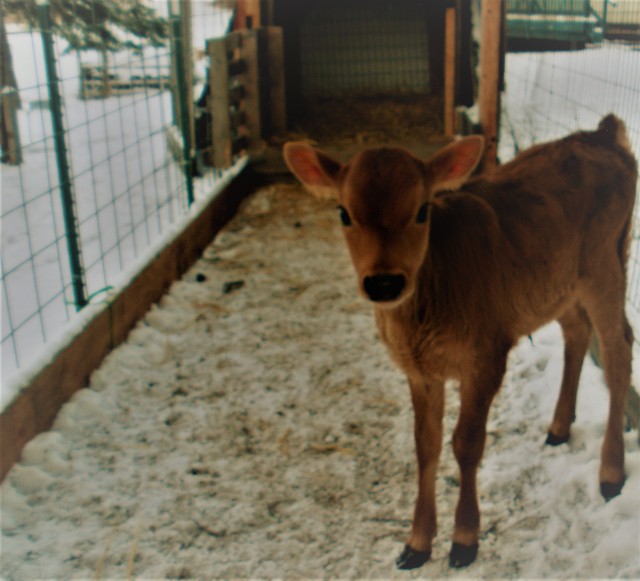
For calves getting fresh milk from their mothers via bottle/bucket:
FIRST TWO WEEKS:
After colostrum, feed 1 bottle of milk (2 qt/half gal.) twice a day for the first 2-3 weeks. Every twelve hours is a good routine to be on, animals do good with consistency! In winter months, a third bottle can be fed mid-day, or split the two bottles into three feedings, if they can’t handle much extra yet.
- Note larger breed calves such as Holstein or Brown Swiss may require a larger feeding of milk as a young calf (three bottles or the one gallon bottles twice a day)
- MILK SCOURS: Calves (particularly when fed high-fat milk) may “milk scour” if the mother’s milk is too rich. Here are some tips:
In my experience, milk scours from too-rich milk are usually gray or white and runny, maybe even liquidy. I’ve seen it stay manure color and just be liquid, but that’s less common. I have seen blood streaks, but that’s less common as well. In all cases, Whew! is it STINKY!!
The calf is usually acting 100% normal, but sometimes they will kick at their belly or hunch when going to the bathroom (it can be acidy).
If the calf is happy, nursing, active, alert, then I proceed as normal, but with either skimmed milk or watered-down milk. Skimmed is nice because you’re getting everything except that excess cream, whereas watered down milk is just…watered down, still proportionally a lot of cream. But both methods should work to relieve the scours. Literally within a feeding or two, the manure should be significantly better and the calf should be back to normal in approx 48 hours.
If I don’t catch it right away, the following can be added to the milk to supplement/improve digestion for a few feedings:
- The following recipes imply a “regular” calf feeding from a half gallon sized calf bottle
- SLIPPERY ELM: Three capsules or 1 Tbsp. included in milk or hand-fed just before feeding milk. Slippery Elm works to soothe the mucous membranes of the intestinal tract, improving absorption of fluids. Dehydration is often the most dangerous symptom of scours in calves.
- RENNET: Add to milk abt. 1/2 tsp. liquid calf rennet to the milk feeding – feed immediately (other rennets will work as well, follow package dosage for what you would use to make a 1 gal. batch of cheese.) Alternately, use a syringe to squirt 1/2 tsp. rennet, diluted in several cc warm water, in the back of the mouth of the calf just before feeding milk. If you wait too long to feed the renneted milk, the milk will coagulate and not come out the bottle. 🙂 This illustrates the reason for using rennet – it helps solidify the milk to slow digestion and temporarily aid in slowing diarrhea.
- Fastrack PROBIOTICS: Can add recommended package dosage to the bottle of milk before feeding. This is an essential addition if feeding milk replacers or questionable milk or if the calf is sick. Fresh, healthy raw milk should have sufficient enzymes for the calf to be able to digest but any processed milks would benefit from the addition of probiotic.
- ELECTROLYTES: Feed regular or skimmed/light milk feeding in AM and PM with a mid-day feeding of electrolytes (half to full bottle of water with % powdered electrolytes added as directed in package. Resorb is a great “calf-specific” brand, but there are also other “multi-species” brands available.) Electrolytes help balance the inner workings of a calf’s digestion (similar as for humans) and helps with hydration while the calf is improving in health.
Grain & hay, or extra water, is not necessary for these calves, as the milk is sufficient. A small handful of hay or grain is fine to try, although the calves may not eat much. Extra water can be put out as long as the calf is not filling up on water and refusing to drink milk (milk is first priority, water is secondary). Extra water can be a good “safeguard” to keep out in hot summer months. That’s something our climate rarely has to deal with, but in hot, humid climates, calves may require additional water beyond what is normal.
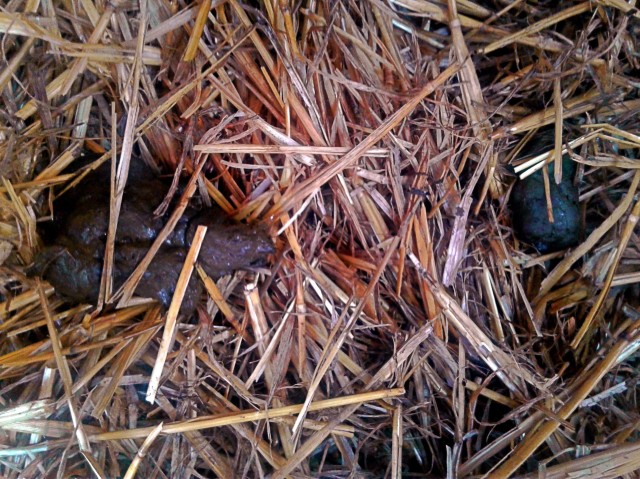
TWO WEEKS to ONE MONTH:
 Continue feeding half a gallon (or your breed-specific amount) of milk twice a day – Do not yet increase the amount of milk. Transition to bucket on same amount of milk and increase amount after the transition has taken place.
Continue feeding half a gallon (or your breed-specific amount) of milk twice a day – Do not yet increase the amount of milk. Transition to bucket on same amount of milk and increase amount after the transition has taken place.
Around 3-4 weeks old, get a bucket to pour the milk into. It needs to be in a sturdy bucket (we like the horse buckets with the built in hooks) and about low-chest height for the calf.
Most likely the calf will not take right to the bucket, so you can help by guiding the calf’s nose to the milk, maybe dab a little milk on its nose or mouth.
You can also dip your fingers in the milk and try to get the calf to nurse on your fingers, then slowly move your fingers down into the bucket until the calf is sucking up milk and you can slip your fingers out.
The most difficult calves, you might have to take a nipple, dip it in milk, get the calf to suck on the nipple, then put the nipple into the milk and get the calf to suck on the nipple until it gets the idea of drinking.
Our easiest calf took to the bucket immediately and never looked back. Some take a few days to get a hang of drinking out of a bucket, so be patient. I promise, they’ll learn!
Grain is still not necessary for these calves, as the milk is sufficient.
You can feed a little handful of hay to get the calf interested, but try not to feed too much hay, as it will get wasted. Fresh hay every day is best, so just a small amount that they can chew on in 12 or 24 hours.
Why do we use a bucket? On our big dairy, heifers were raised in groups of 6-8 heifers. If they nurse on a bottle or on their mother for months, then they want to keep sucking things. This can lead one heifer to suck on another. Might be ears, might be on the face, but it might also be on the little teats of a heifer. Sucking can cause irreparable harm to a heifer’s future mammary system and sucking on ears can cause unsightly cuts and tears. By bucket feeding, that issue is reduced and calves can start to consume milk in a larger quantity. So buckets provide larger milk feeding capabilities for the maturing calves, convenience for the farmer, less risk of “sucking” on other calves, and mimicking how a calf will learn to drink water.
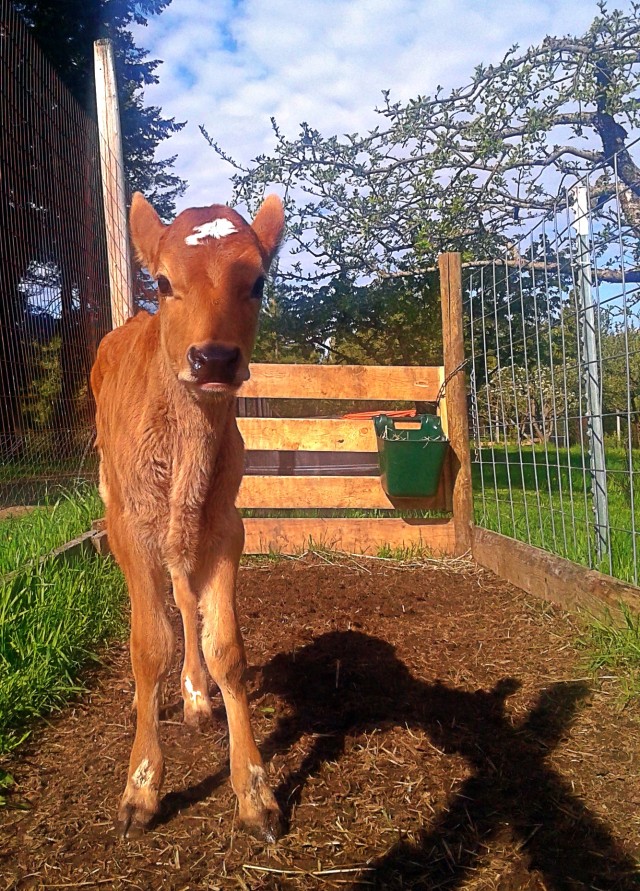
ONE MONTH to WEANING:
 MILK: After a month old, and if you have excess milk, you can increase the amount of milk to feed the calf. Our dairy heifers drink around 1.5 gallons of milk per feeding, twice a day. They grow really well on this. Our steers get closer to 2 gallons twice a day (four gallons per day total) because we want to put weight on quick!
MILK: After a month old, and if you have excess milk, you can increase the amount of milk to feed the calf. Our dairy heifers drink around 1.5 gallons of milk per feeding, twice a day. They grow really well on this. Our steers get closer to 2 gallons twice a day (four gallons per day total) because we want to put weight on quick!
Gradually increase milk from half a gallon per feeding to more. Add a pint more every couple of days and watch their manure closely – if the manure gets soft, do not increase their milk for a few days (or decrease a bit if they get the runs). Our calves are three months old by the time they’ve developed the capacity to drink 1.5 or 2 gallons of milk at a time.
The natural process of weaning takes up to 10 months. Dairy producers wean their calves in two months. … It’s clear that the full development of the rumen GI system in dairy calves is a complex process that most likely takes longer than we’d like it to. John Hibma – Impacting Digestive Development in Neonatal Calves
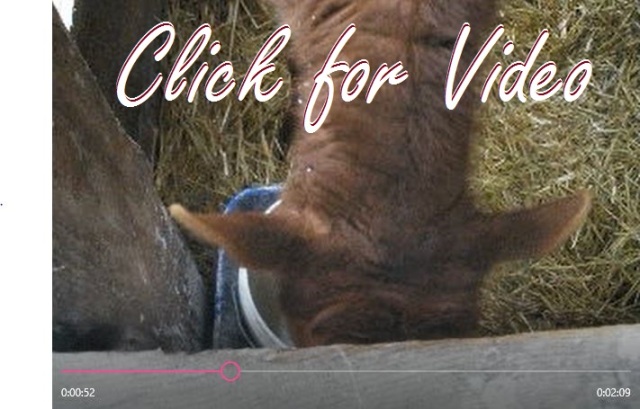
GRAIN: We choose not to feed grain, but instead to make sure they get ample supply of milk. If your milk supply is limited, 1 gallon of milk per day is bare-bones minimum. By a month old you would need to start supplementing that diet with some grain (a cup or two daily) and increase grain as they learn to eat it.
HAY: By 1-2 months old, they’re learning to eat hay and by 4-5 months old, they’re eating a whole flake per day.
WEANING: After 5-7 months old, you can decide when to wean – depending on milk supply, convenience, growth of the calf, etc. (The minimum time on milk should really be 3 months, although some feed calves milk replacer only 2 months and then feed heavy grain the next several months.)
We make sure the calf is drinking cold water and eating plenty of hay before weaning.
Trick to teaching a calf to drink water:
When thinking about weaning, start diluting the milk with warm water. Gradually reduce the amount of milk over several days or weeks until the calf is getting warm water. Then gradually reduce the temperature of the water. Soon you’ll be giving them cold water and they won’t realize what even happened!
Alternately, it’s a good idea to offer water to calves or keep a small trough handy so they can learn to drink cold water on their own. This can be difficult in frozen winter months, but in summer months water should be available daily to older calves.
Really young calves may fill up on water and then not drink their milk, so be careful to monitor young calves and make sure they are drinking milk first, water second.
By 6-8 months old, a dairy steer or heifer should be able to grow on a hay/pasture diet alone. You can keep feeding a small amount of grain (a few pounds) if you want, but it is not a necessity.
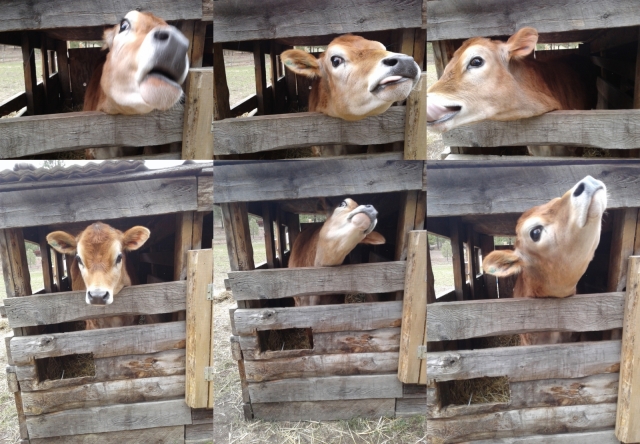
If weaning at less than 5 months, the calf may need to be supplemented with a little grain to prevent the potbellied effect for a couple months.

For calves on milk replacer:
We highly recommend feeding a non-medicated milk replacer. In addition, look for milk protein rather than soy-based replacer.
 After colostrum, feed a 1/2 gallon milk bottle, twice a day. Try to keep a very consistent water temperature, close to but not exceeding a cow’s body temperature (101.5 F).
After colostrum, feed a 1/2 gallon milk bottle, twice a day. Try to keep a very consistent water temperature, close to but not exceeding a cow’s body temperature (101.5 F).
We always, always, always feed probiotics for milk replacer calves!! Your local farm store should sell them, and dosage is on the package (and comes with a measuring spoon).
Around 2 weeks old, transition to a bucket. At a week or two old, they will start to eat a little grain. They can also get some hay, but if you are worried about weight gain, then go for grain first and bring in hay a couple weeks later, just an handful or so. They’ll just nibble at the feeds and gradually you can increase the rations of grain and hay as they eat more. We usually work up to 1 flake of hay and perhaps 2-3 pounds of grain available to them daily at around 8 weeks and older.
In cold weather, a third feeding is advised to maintain energy levels so the calf does not start taking from reserves. We encourage the use of domes, especially when raising multiple calves. Individual housing greatly reduces the spread of disease. The design of a dome makes a warm, snug, dry home for a calf. Domes work for 2-3 months, and then larger housing is necessary.
Anywhere between 8 weeks and 3 months, you can decide when to transition off of milk replacer onto warm water and then cold water. (Feeding milk replacer longer than 3 months is very expensive and not really the best utilization of feed.) Note, we never condone weaning at a young age (some people do as young as 6 weeks!) unless the calf just absolutely cannot handle milk (yes, that happened once, was born sickly and no matter what we tried, he never took to milk!).
If you transition early, you will need to supplement with more grain. If you are having scouring problems, an easy solution is (IF old enough, 6 week is absolute minimum) to stop replacer and simply feed grain, hay, and water. That should stop any reoccurring scouring.
For calves on their mothers:
 No supplementation is needed. Make sure that the calf has access to water and some hay, so that they can start developing those tastes. At weaning time, they should be able to eat a full hay/pasture and water diet.
No supplementation is needed. Make sure that the calf has access to water and some hay, so that they can start developing those tastes. At weaning time, they should be able to eat a full hay/pasture and water diet.
Weaning: A mother may or may not wean her calf. A calf can be weaned anywhere between 3 and 10 months. A normal average would be between 6-8 months old for natural weaning. After 6-9 months, the valve that bypasses the first three stomachs closes off (the valve that diverts milk to the fourth stomach, where rennet coagulates the milk. Awesome, huh!) That means that they need to be weaned in that age range. Milk is for babies, hay is for adults!
Our beef cow always weaned her calves around 9 months and did the job herself by kicking the calf off and drying up her own udder.
 Some cows are so maternal, they won’t do the job! Then, you have to help her out by either removing the calf to an area where it cannot reach the mother to nurse or buying a type of weaning ring. We use a yellow plastic ring that just slides into the nose (no piercing or poking) and there are little spikes on top and the edge to discourage nursing.
Some cows are so maternal, they won’t do the job! Then, you have to help her out by either removing the calf to an area where it cannot reach the mother to nurse or buying a type of weaning ring. We use a yellow plastic ring that just slides into the nose (no piercing or poking) and there are little spikes on top and the edge to discourage nursing.
If weaning at under 5 months, the calf may need to be supplemented with a little grain to prevent the potbellied effect for a couple months.
Does a calf need to be weaned?
Yes! A cow needs a break between calvings. (So do humans, in case you’re wondering! 😉 )
If she nurses one calf right up to the birth of the next, she has not built up her bodily reserves, plus the older calf is stealing the vital colostrum for the baby. A calf cannot survive without colostrum.
Older calves can start to bite and beat up on the cow’s udder, and no one deserves to be beat up!
A resting period is essential for a cow, and studies have shown that a period of rest leads to a healthier lactation and better reproduction.
Scours:
A healthy calf getting milk from its mother should not scour, because the raw milk has so many active enzymes and bacteria. If a calf does scour, you can read below about dealing with scours. Most likely, a mom-fed calf scours because of too much milk, so scale back if you think that is the problem and see if it corrects itself. If manure is orange or brown, it should be fine. If the manure is gray/white or bloody, you should contact your vet immediately. Many replacer-fed calves tend to scour, which can make management of purchased calves more difficult.
For treatment of scouring: Treatment depends on each individual case.
Start with electrolytes (such as Resorb):
- Continue AM and PM milk feedings
- Mid-day add one packet of electrolytes to warm water and give to calf
- If they’ll take it, you can give electrolytes again just before bed
- Don’t mix milk and electrolyte feedings!
For cases where electrolytes aren’t enough:
For calves over 1 month, you can use Sustain III bolus. They are long acting pills, so one is sufficient to kill off any bad bugs.
You can start with something milder (like Terramycin (oxytetracycline)) if you think it’s a mild case of scours.
You may not even need antibiotics if adjusting the amount of milk or adding more probiotics is enough to stop the scours.
Worst case scenario, your vet can get you Excenel, which is 1cc for 5 days (We get a 6cc syringe filled, to make sure calf gets a full cc per day and just replace the needle each day.) That should kill off anything, and should only be used if other methods don’t work. Definitely ask your vet first!!
Disease prevention:
Cows CAN transmit disease to their offspring through the milk. We recommend speaking to your dairy vet about testing (and later vaccinating for some of them) for: Johnes, BLV, BVD, bovine Tuberculosis, and anything else that may be applicable to your area. Additional disease prevention is to have a closed herd. Avoid ever buying animals from sale barns and auctions, because the sheer volume of animal leads to spread of infectious disease. (A dairy auction held by a reputable company such as the American Jersey Cattle Association is a different story, they are held infrequently and the animals are all tested for many things before sale and are safe to purchase. They are sales focusing on quality and not quantity.)
A note on university and scientific studies on calf raising:
Most book and online sources are focused on commercial calf raising. If you are feeding milk replacer, then they’ll need to be raised differently than if they were fed fresh raw milk. Commercial attitude is a little milk replacer and huge amounts of grain. That creates the most DEVELOPED stomach, but not the HEALTHIEST stomach. The basic reasoning is that we want to produce healthy, long lived animals. Our goal is not to have the largest dairy heifers or ones that can calve at 18 months old and thrive in a pushy commercial environment for 1.4 years before succumbing to death. Besides, cows were never created to eat a full grain diet. They are ruminants, meant to live on grasses and legumes and slowly digest their food. So anyway, there you know our thoughts! (Still, cool pictures of calf stomachs if you’re interested: http://www.das.psu.edu/research-extension/dairy/nutrition/calves/rumen Universities also advocate feeding calves once a day to cut costs and pasteurizing all products, so keep that in mind when you read their “research”!)
Vaccinate, when?
We like to vaccinate when calves get their brucellosis shot (“Bangs” vaccination). Bangs is given to heifers between 4-12 months old. They must be 4 months old at minimum, and a vet is required to give the shot/tattoo.
Calves also get a Bovi-Shield Gold vaccination at that time.(Update: We now have a closed herd and choose not to calfhood vaccinate any more, except for Brucellosis)
And have the vet check for extra teats, this is a great time to snip off any extra teats before they have a chance to develop. Just make sure you’re cutting off the extra teat and not one of the main teats.
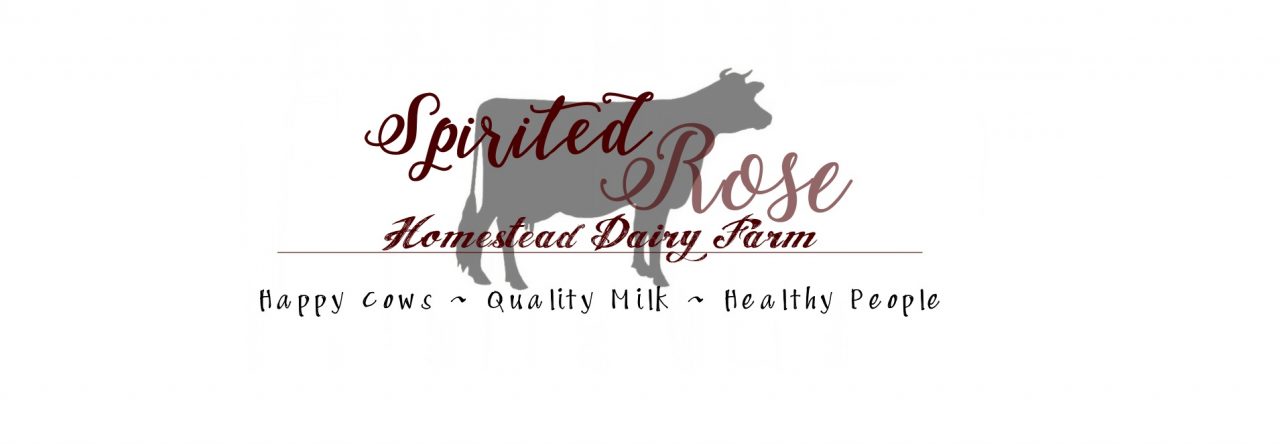

I have a 16-month-old Jersey that we plan to breed once she reaches 18 months old. It is approaching winter here and I want to give her something other than sweet feed as a treat or supplement for hay and grass. Any thoughts?
LikeLike
Is she of healthy weight? If so, you could breed her now or anytime soon. Likewise, if she is a good weight, you’ll really want to limit treats, to prevent her from getting fat. A few sweet feed alternatives could be: alfalfa pellets, thinly sliced apples, sliced cabbage or beets.
LikeLike
Hi!
We took in a Jersey steer – hes about 9 weeks old. On milk replacer. I was told not to give hay until after he was eating grain. However, I cannnot get this calf to eat grain. I’ve tried two different types and he just nibbles here and there.
His bottle is twice a day, total 1.25 gallons a day.
Beyond the weaning/grain he has attempted to mount myself when bending over as well as our pigs (rarely has access) and can be pushy. He will be a family cow, and I’m seeing this behavior as a dominance dance toward his “herd” and need to know how to correct this?
Thank you!
Shannon
LikeLike
Hi Shannon,
My husband thinks the stomach environment from milk replacer may in itself make the calf’s stomach fairly tender, then adding in grain could increase acidic content and therefore may not be very palatable for the calf. You have several options. This late in the season, you may not have much pasture, but getting the calf to eat some pasture would be a nutritious substitute for hay. If no quality pasture, then high quality hay would be an option – something like third cutting alfalfa hay with tender stems. When feeding grain, start out with only a cup full and refresh the grain once or twice a day. Give any old grain to chickens, etc. and make sure the calf gets fresh. Sprinkling Probios or a similar probiotic on the grain (or adding more to the milk) could help balance the digestive system of the calf, in addition to feeding a little hay.
There are many opinions on how to feed a calf. Personally, we believe in a balance between health and growth, so feeding some hay along with the grain should be healthier for the calf’s rumen pH than feeding grain alone.
As far as personality – any milk fed calf can be pushy for their milk. You may need to put physical barriers in place – such as locking him into a smaller pen, then putting out his bottle/bucket of milk, then opening his pen so he can access the milk. Also, treat him like a bull – do not turn your back on him, do not lean over where he can jump on you, do not pet him on his forehead (pet under the chin and on the neck, keep his head high). Once he’s off milk, he should settle down some. Having other animals as the herd (instead of humans as the herd) can also calm him down.
LikeLike
Thank you so much!
He does have access to pasture for short amounts of time during the day, but I’m also in the process of locking down my winter hay.
I will add the probiotics as you suggested and hopefully that will help. I had started him on milk that arrived with him (this was a rescue situation) the milk was making him sick so the vets had me switch him to replacer. He definitely has a sensitive stomach, but a lot of spirit 🙂
I appreciate your help!
LikeLike
Yes, young calves are all tender… he’s getting enough milk for now, hopefully over the next few weeks you’ll see him gain an interest in the grain. 🙂
LikeLike
Thanks for all this information. When we got our first cow we thought it was cruel to remove the heifer from her so we let them be together. Now we have a 16 month old heifer which is obsessed with milk and if she can find a way to get to her mum’s udder she’ll do it and she is so aggressive to the cow. Her mum never kicks her away. It’s a very stressing situation. Now we are expecting another baby from the same cow but we don’t want to make the same mistake. Would it be best to remove the calf immediately after birth? I would really appreciate some advice.
LikeLike
I’m sorry, this was sent to my spam box so I’ve just now found it.
You may want to sell the current heifer or else keep her completely separated from the cow until she herself is a cow and then see if that stops the nursing (most heifers “grow up” when they become cows). A weaning ring is not likely to be effective if she’s that persistent already…
Considering your specific situation, and if you plan to keep the next heifer and not sell her, then yes, separating after birth is a good idea. The mother cow has work to do (making milk) and the calf can still be fed fresh milk (via bottle/bucket). What I like to say is, it may not seem the nicest to separate a calf from its mother, but separating creates 1. a workable cow, 2. a friendly mindful calf and if you put them together down the road, they get to live the rest of their lives together. Our cow Rosebud is the daughter of Proud Rose, they have lived together for 11 years! Rosebud is 12 and Rose 14. They now also have little sister Prancer living with them. She’s a bred heifer. Rosebud and Prancer were raised away from Rose for the first 6-8 months, but then they go back in with the herd (or with a group of heifers) and eventually are living back with their mom with no issues. So, in the short run – separate, allowing them to be together in the long run.
LikeLike
I am zero grazing farmer in Kenya.which is the best type of dairy cow to keep
LikeLike
If you do not have any grazing/pasture available, I would not recommend a dairy breed of cow. You could consider a dual-purpose breed, depends what is in your area, but perhaps a Shorthorn, Dexter, Devon, etc. would provide some milk without demanding the highest quality feed.
Maybe a dairy goat would work better, as they require much less feed.
LikeLike
Hello again! I have another question based on a previous question.
First the background: Our new Jersey cow had her calf a month ago. We had finally gotten down a routine that worked – we separated mom and calf except during milking. Calf got two teats and we got two teats and we milked her three times per day. However, in the past few days, we’ve noticed signs that the calf had been getting to mama through the fence. Today, we moved calf to a completely separate area so he could not feed off mama. We also recently got a surge milker setup going and have used it on mama (2 teats) for the past two days. We have also reduced our milkings to once in the morning and once in the evening. We also used oxytocin for a few days a couple weeks ago and figured out that she produces 2 gallons per day (1 gallon am, 1/2 gallon afternoon, and 1/2 gallon night) in our two teats.
So the problem: Over the past few days (since we began with the milker) we’ve been getting half as much milk. This started the day before the surge milker – but we’re almost sure that calf got to her the first day. We are still getting half the milk, even though the calf had absolutely no access to her today.
THE QUESTION: Would using a surge milker be stressing her out enough to reduce the amount of milk we’re getting? We did use the oxytocin yesterday, thinking that might be the problem, but still only got half as much milk. Is there any other potential reasons why our Jersey would be producing less milk at one month than she was earlier in her lactation? Is there anything you would recommend we do to increase her milk supply?
Thank you so much… it’s so wonderful to have a resource with experience to ask these questions because so few people really know anymore!
LikeLike
Yes, milking by machine is a big change. You may need to use the oxytocin a few times. If her production is still down, even with the oxytocin, then I would review ketosis to see if she fits the symptoms.
LikeLike
OK, we will use the oxytocin a few more times and also make sure she is not having ketosis issues. Thank you so much!!
LikeLike
Thank you for sharing your knowledge! We newbies need lots of help! It’s a lot of work and worry, but so worth it. I just love your website! I used your info when my cow had udder edema. We got through it just fine! I’m sure we’ll get through this as well! 😊
LikeLike
She’s making about 8 gallons a day. She gets 8 lbs of 12% + 8 lbs of 16% + 4 lbs alfalfa pellets broken up over two feelings per day, at the vet’s recommendation. I did wonder if the 16% was a little high. We’ve been trying to train the calf to drink out of a pail following the directions on your website, but no success so far. Mama’s conditions isn’t as bad as it was before we upped her feed, but she hasn’t come back into heat, so I thought maybe weaning him and getting her on OAD milking would help. However, I don’t want the calf to suffer either. She does look shiny and energetic, just too bony.
LikeLike
16.5% is the ideal digestible amount of protein for dairy cows – which is why that’s what most dairy grains are. It looks like a good program your vet has you on. 8 gallons is a lot of milk to be giving at 3 months fresh, for a family cow!
If you’re letting the calf nurse, he won’t likely take to the bucket – you’d have to wean the calf from mom and let it get hungry, then it’d learn the bucket. 🙂
Some cows don’t have heats while they’re nursing calves, plus a thin cow giving 8 gal at 3mo fresh – I’m not surprised she hasn’t had a heat yet. Weaning calf to a bucket may help.
I would not recommend going to OAD milking – 8 gallons is a lot of milk and you’d sure risk some issues like mastitis or protein poisoning by trying to only milk once a day.
If it were my cow, I’d just keep up on the feed program, milk twice a day, and give her a longer dry period when the time comes. You might also talk with your vet about how to handle the next lactation, what you might do for a feeding program to try to keep her from milking so much. One thing I’ve heard, is to not feed grain until after the cow has calved, and slowly increase to her amount over the first two weeks in milk. You’d want to keep a close eye on her for ketosis, but that method might work for you.
LikeLike
Thanks so much! How long would you give a calf to learn the bucket? We gave him three days of no nursing, but he didn’t catch on, and I finally let him nurse. He doesn’t want to suck on my fingers or on a bottle. He’s big and it’s a rodeo! Is he too old to learn?
LikeLike
The older they are, the slower to learn. Calves can be quite stubborn. I wouldn’t let him back on the cow, otherwise he’ll know he can hold out for that. You can always keep the bucket of milk in his pen and dump out whatever he doesn’t drink when you pour in the next feeding. Keeping hay, grain, and water available could help too, just to teach him to start nibbling and drinking from the water bucket. You can put his nose down into the bucket to get a little milk on his nose, but after trying enough times, it’s just stubborn will and time is all that will work, til the calf gives in and takes off. 🙂
LikeLike
Hello! Our calf is 3 mos. old, and the mama is making tons of milk, but is too thin. I’d like for her to make less milk so that she can gain weight. She’s eating 16 lbs of grain, plus alfalfa for the calcium. Would it be best to wean a little early for the sake of the mama?
Or, maybe let the calf nurse only once a day?
Thank you!
LikeLike
How many gallons (or pounds) of milk is your cow giving per day? What % protein is your grain? (Try feeding a lower protein grain, high carb = body condition. protein = milk production.)
Yes, you could limit the amount of time the calf nurses, if your cow is ok with that. I’d still recommend the calf get 2 feedings a day – whether that means you milk the cow and bucket feed the calf, or bring the calf in to nurse.
Some cows are just heavy producers, there’s not a lot you can do except feed her really well. You can also give her a longer dry period in hopes that she can put some body condition back on before calving (not to allow her to get fat, but to get her to a healthy fresh cow body condition. https://spiritedrose.wordpress.com/jersey-cattle/medicine-box/body-condition/
LikeLike